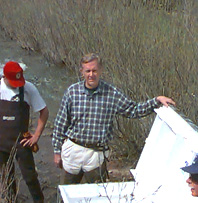|
|
|
|||||||
|
A Colorado River Swan Song Secretary Bruce Babbitt bids good-by to the Colorado River Water Users Association. LeRoy W. Hooton, Jr. December 18, 2000
Earlier, usually sharp spoken General Manager of the Southern Nevada Water Authority, Patricia E. Mulroy set the tone. Mulroy, as the welcoming speaker, lauded recent progress in solving problems on the Colorado River. Nevada's water banking agreement with Arizona and the Surplus Operating Agreement that gives California a time-certain period to cut back to its 4.4 million acre-foot allocation were reasons to be upbeat. She praised those who have managed the Colorado River's resources and the resulting benefits the river provides the western United States. Babbitt described his rein over the river as a time of transition and change, characterized as one of not pouring concrete, but building relationships and partnerships. He said, "during this period I widen the circle," by bringing in the tribes, environmental issues and most recently, the Mexican issue. He used the Virgin River in Utah as an example of successfully widening the circle. Bringing the stakeholders to the table, "saved a small stream that looked like it would be dried up," said Babbitt. Working together, St. George is sharing its infrastructure and a new water treatment plant with the Shivwits tribe. He further praised the Upper Basin endangered fish recovery efforts, noting that the federal government is committed to help finance the recovery program. The contrast between Babbitt and his predecessors was vividly exhibited when former Commissioner of Reclamation Floyd Dominy (1958-69) debated the subject of draining Lake Powell with Dave Wegner, Science Director of the Glen Canyon Institute. Still firm in his beliefs, Dominy now 91 years of age, spoke of the benefits enjoyed by mankind in developing the Colorado River. “We had no naysayers then. Everyone was behind putting water to work,” he said. When asked about the Endangered Species Act, the colorful Dominy said it was bad legislation and compared it to the “Volstead Act”(The National Prohibition Act). There were no NEPA requirements in those days noted Dominy. Glen Canyon Dam was under construction 6-months after authorization. Both Dominy and Babbitt are metaphors of their time. In Dominy’s time, developing the West’s resources was a national goal. Today, in Babbitt’s time, there is more concern about the environment and preserving the West’s resources. Babbitt took the mid-ground on draining Lake Powell. "Glen Canyon Dam is not in any danger of coming down," said Babbitt. He did say that the dam could be operated to enhance other values, "without reducing one drop of water." Noting that it could affect peak power, he said, "There are alternatives that are important," in referring to the downstream environs of the river. Describing his style as one of running his finger nails down the black board, to get everyone's attention, he described himself as a "water buffalo" in one breath, then reiterated his claim as being the first Secretary to tear down a dam. "I realize that I purposely created the image of wanting to tear down dams. There are 75,000 dams, and I only tore down about 20," he said. "Don't try it," Babbitt warned when he spoke about efforts to get rid of the Endangered Species Act. "The Act has the overwhelming support of the American people. . . Americans cherish God's creations, and support every form of life."
Despite Babbitt's words of support, a later conference program panel discussion on the subject, indicated a long and protracted process to resolve this matter. State’s rights surfaced as a problem. Susan Lieberman, Department of Reclamation, Water and Science Department, said that the United States is authorized to enter into international treaties, but it does not have the authority to enter into an agreement (giving a state’s water right to a foreign country). Michael Cohen, Research Associate Pacific Institute for Studies in Development, Environment and Security estimated that 32,000 acre-feet of water per year is needed with a 250,000 acre-foot pulse every 4 or 5 years to restore the Delta. The needed water will have to come from existing users. Wayne Cook, executive director of the Upper Colorado River Compact Commission, likened the situation to being invited to a birthday party and then being asked to bring the birthday cake. Notwithstanding the water right issues, there were a few voices in the audience supporting a solution with Mexico to recover the Delta. Babbitt praised the California Surplus Operating Agreement that would bring California use of the Colorado River down to the 4.4 million acre-feet it is entitled to under the compact during a 15-year interim period. He praised California water users for saving 700,000 acre-feet of water. Describing the negotiations, Babbitt said, "The processes were first to engage, then use existing institutions, don't jump to conclusions and give it time." However, using President Reagan’s cold war phrase, he cautioned Arizona and Nevada to "trust and verify." Babbitt's words were well coined, and in later panel discussions on the agreement, both Arizona and Nevada water officials reluctantly agreed that it was the best deal they could get. Larry Dozier, Deputy Director of the Central Arizona Project asked “Why would Arizona want to do this. It’s the most likely to be at risk in years of shortage." Showing signs of negotiating fatigue, David Donnelley, Deputy Director of the Southern Nevada Water Authority, exclaimed, "Nobody really loves it, but what's the option? The river will be in chaos if not accepted" Larry Anderson, director of the Upper Basin Utah Division of Water Resources, told the Utah caucus earlier that he supported the interim agreement. Babbitt concluded by giving advice to the river stakeholders in dealing with the river. "Widen the circle, have faith in the future and there is enough water for everyone with efficiency and conservation." He left with a standing ovation by the large gathering there to hear his final words. Related Links: www.slcclassic.com/utilities/news10102000.htm |

